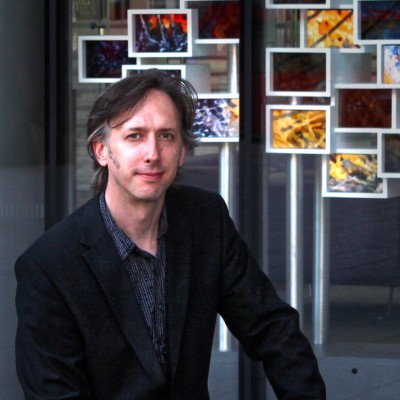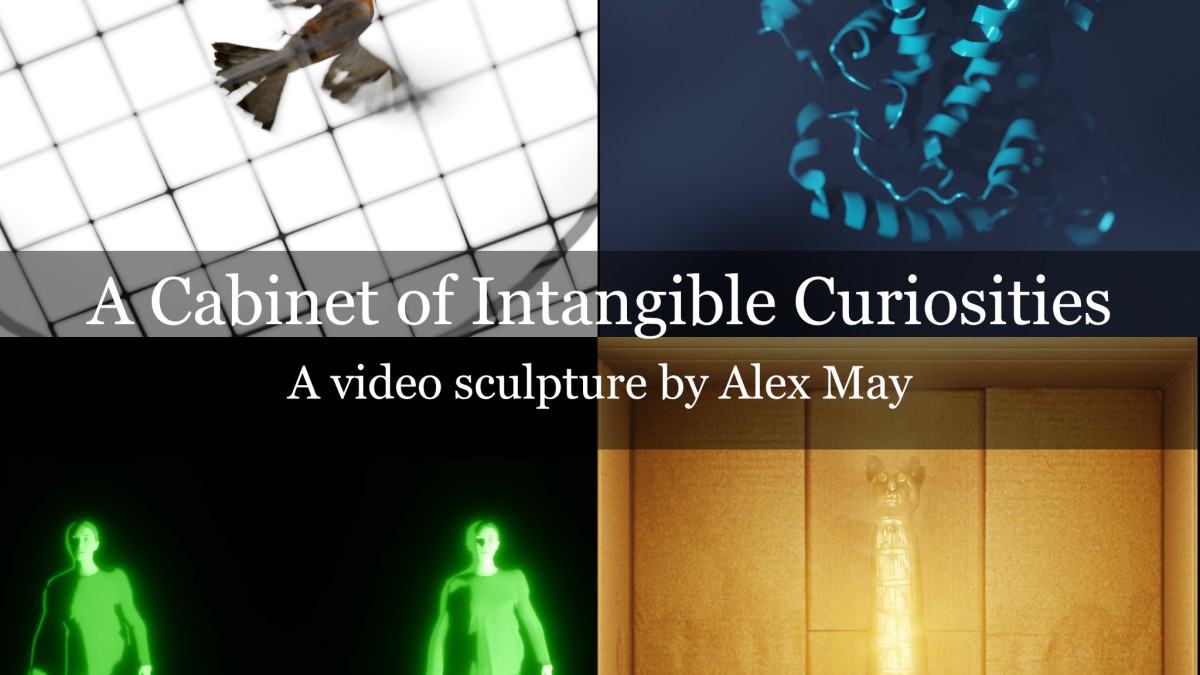Self-navigating robins and spherical cows: Q&A with artist-in-resident Alex May
Digital artist Alex May – an Institute of Advanced Studies (IAS) Fellow – will display an exhibition of his work on Thursday 11 July which explores the mind-blowing topic of quantum biology.
Quantum biology looks at how quantum effects (where particles can be in different places at once, or travel through seemingly impenetrable barriers) influence the way living organisms function, which could explain processes like DNA mutation in humans. Surrey leads the way in furthering this field, both through our prestigious ‘Quantum Arrow of Time’ project funded by the John Templeton Foundation, and our Leverhulme Quantum Biology Doctoral Training Centre.

Now an award-winning digital artist has turned his attention to exploring quantum biology through art. Visiting Surrey as its second ever visual artist-in-residence under the IAS Fellowship scheme, Alex May has been collaborating with his host Dr Youngchan Kim, the Templeton project team and colleagues in the School of Biosciences, and will unveil an art exhibit on Thursday 4 July which takes an innovative look at a seemingly unknowable concept.
We caught up with Alex to talk about his Fellowship and forthcoming exhibition.
Could you tell us a bit about your work as an artist?
I’m based in Brighton, and I specialise in digital art with a focus on memory and identity both in a personal and societal context. This has led me into the world of science where my understanding of technology allows me to bridge the ‘language gap’ between science and art.
Quantum biology is an incredibly complex topic. What piqued your interest?
I liked the idea that quantum effects are potentially acting at a higher biological level than the quantum mechanics that underpin everything. It felt like it brought an intangible world closer to something we could relate to in our conscious bodies, at least on a metaphorical level.
For me, it has parallels with the idea of memory and how we remember things. Two people can experience the same event and have a shared memory that could be considered entangled, in a purely metaphorical sense of course. The remembering, the telling of the memory, acts like an observation of a quantum state, subtly changing the memory and breaking the entangled experience.
Tell us about your IAS Fellowship at Surrey?
I met Youngchan, my Fellowship host, through his involvement with a previous IAS artist-in-residence, Anna Dumitriu. I found the subject area fascinating and it had immediate parallels to themes in my artistic practice.
During the Fellowship, I’ve had the opportunity to talk with researchers doing the hands on lab work, as well as discussing the project with other Faculty staff including Dr Andrea Rocco and Professor Jim Al-Khalili. I was invited to attend a Templeton Foundation team meeting, which was a fascinating and intense window into the wide-ranging and varied work that goes into science that outsiders don’t get to see.
Can you give us a preview of what you’ll be unveiling at your exhibition?
I’m producing a video sculpture – a physical sculpture that has a screen embedded in it – based around the concept of a ‘cabinet of curiosities’. Before museums, explorers would bring home specimens from far-flung lands that would end up in private collections of the rich and powerful. This was before taxidermy, so exotic animals were included through biological artefacts such as skulls, teeth, and bones. I thought this was an interesting metaphor for quantum biology where we cannot see the actual quantum effect that exists in this distant other land, instead we are looking for its result – an artefact of its existence; like a shadow of something you can’t look at directly.
One part of the work will highlight the story of the discovery of how the European robin can navigate the earth’s magnetic field using an interaction between a protein called cryptochrome that is present in its eye and photons of blue light, which is believed to utilise a quantum process.
When and where will your work be exhibited?
The exhibition will be part of a workshop on quantum biology on Friday 5 July at Surrey. An 'In conversation' event on Thursday 11 July will be opportunity for staff and students to come and see the exhibit. I’ll later look at opportunities to show the work internationally as part of other exhibitions.
Now you’re almost at the end of your residency, what has been the highlight?
The thing I’ve most enjoyed has been spending time talking with Youngchan, the Templeton team and other scientists around the university. It has been challenging, mainly because quantum biology is very theoretical and its experiments are largely data driven, so for a visual artist, there wasn’t much to ‘see’: experiments in this area include firing single photons in the complete darkness of a laser lab.
I think Fellowships like this IAS artist-in-residency are a wonderful and powerful model. It affords artists a unique opportunity to get deep into cutting-edge scientific research and fosters meaningful trans-disciplinary discussions where novel ideas and perspectives can be shared. I’m very honoured to have had this opportunity and am looking forward to presenting my artwork.
